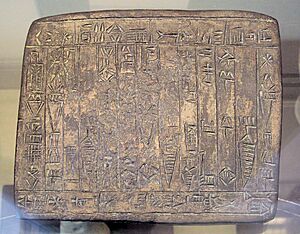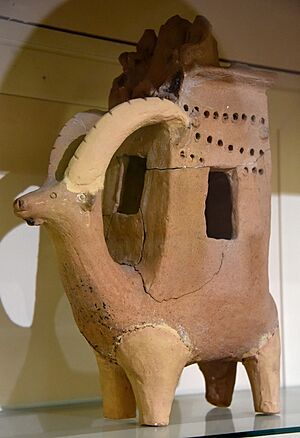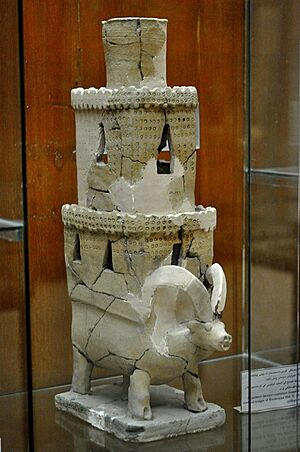Hurrians facts for kids
| 𒄷𒌨𒊑 | |
|---|---|
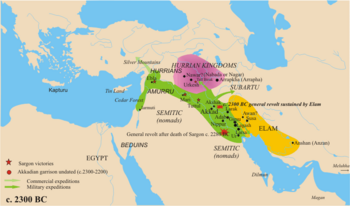
The approximate area where the Hurrians lived in the Middle Bronze Age (purple area).
|
|
| Regions with significant populations | |
| Near East | |
| Languages | |
| Hurrian | |
| Religion | |
| Hurrian religion |
The Hurrians were an ancient people who lived in the Ancient Near East during the Bronze Age. They spoke the Hurrian language. Their homes were in northern Syria, upper Mesopotamia, and southeastern Anatolia.
The Hurrians first appeared in the city of Urkesh, where they built their first kingdom. Their biggest and most powerful kingdom was Mitanni. Many Hurrians also lived in the Hittite Empire in Anatolia. Hurrian culture and stories greatly influenced the Hittites. By the Early Iron Age, the Hurrians had blended with other groups. Later, the state of Urartu covered some of the same lands. The Urarteans were a people related to the Hurrians.
Contents
A Look at Hurrian History
Early Beginnings (Bronze Age)
The Khabur River valley became a central area for the Hurrians for about a thousand years. The first known Hurrian kingdom grew around the city of Urkesh (now called Tell Mozan). This happened during the third millennium BC.
There is proof that the Hurrians were allies with the Akkadian Empire of Mesopotamia. This shows they were strong in the area by the time King Naram-Sin of Akkad ruled (around 2254–2218 BC). A king of Urkesh named Tupkish had a queen named Uqnitum.
Middle Bronze Age: Kingdoms and Migrations
During the Middle Bronze Age, Hurrian names started appearing in northwestern Mesopotamia. They were also found near Kirkuk in modern Iraq. Their presence is confirmed at sites like Nuzi and Urkesh. They eventually settled in a wide area of rich farmland. This stretched from the Khabur River valley in the west to the Zagros Mountains in the east.
Around the early second millennium BC, the Amorite kingdom of Mari took control of Urkesh. Urkesh then became a city that had to follow Mari's rules. Later, Urkesh became an important religious place for the Mitanni.
The Hurrians also moved further west during this time. By 1725 BC, they were living in parts of northern Syria, like Alalakh. The kingdom of Yamhad, which had both Amorite and Hurrian people, fought for this area. They battled with the early Hittite king Hattusilis I around 1600 BC. Hurrians also settled in the coastal area of Adaniya in Kizzuwatna, southern Anatolia.
Yamhad eventually became weaker compared to the powerful Hittites. But this also allowed Hurrian culture to spread into Anatolia. The Hittites were greatly influenced by Hurrian cultures for many centuries. The city of Shibaniba (Tell Billa) might have been important then too.
The Mighty Mitanni Empire (Late Bronze Age)
The Mitanni Empire was a powerful kingdom in the region. It was bordered by the Hittites to the north and Egyptians to the southwest. To the southeast were the Kassites, and later, the Assyrians to the east. At its largest, Mitanni reached the Taurus mountains in the west (Kizzuwatna). It stretched to Tunip in the south, Arraphe in the east, and north to Lake Van.
You can see their influence by the spread of Hurrian place names and personal names. After some problems about who would rule next, Mitanni fell to the Hittites. Later, it came under the control of the Assyrians.
The Hurrian kingdom of Mitanni first became powerful before 1550 BC. It was mentioned in the records of Egyptian pharaohs Thutmose I (1506–1493 BC) and Thutmose III (1479–1425 BC). Thutmose III is known for the Battle of Megiddo in the 22nd year of his rule. Egyptians often called the kingdom Naharin.
Later, Mitanni and Hanigalbat (the Assyrian name for Mitanni) appear in the Amarna Letters. These letters were from the time of Pharaoh Akhenaten (1353–1336 BC). Records from Mitanni have been found at many sites. These include Hittite places, Tell Bazi, Alalakh, Nuzi, Mardaman, Kemune, and Müslümantepe.
Another important Hurrian center was the kingdom of Arrapha. Digs at Yorgan Tepe, ancient Nuzi, have taught us a lot about the Hurrians. Hurrian kings like Ithi-Teshup ruled Arrapha. But by the mid-fifteenth century BC, they were under the rule of the Great King of Mitanni.
The Rise of Urartu
At the end of the second millennium BC, the Urartians became powerful. They lived around Lake Van and Mount Ararat. They formed the Kingdom of Urartu. During the 11th and 10th centuries BC, this kingdom grew. It stretched from the Caucasus Mountains in the north to northern Assyria and northern Ancient Iran in the south. It controlled much of eastern Anatolia.
Some experts believe Urartu was a new group formed from earlier Hurrian people. This is mainly because their languages are similar. However, not everyone agrees with this idea.
The Last Hurrian Strongholds
After the Hittites destroyed Mitanni around 1350-1325 BC, the term Shubaru was used. Assyrian writings used it to refer to the remaining Mitanni people in the upper Tigris valley. The Shubaru people rebelled against the Assyrians many times.
The term Shubaru is linked to Shubria. This was a country north of the upper Tigris River valley. Shubria was located between Urartu and Assyria. It was an independent kingdom until Assyria conquered it in 673–672 BC. The Shubrians worshipped the Hurrian god Teshub. Several Shubrian names have Hurrian origins. Hurrians were part of the Shubrian population and may have been the main group.
Some scholars think Shubria was the last part of Hurrian civilization. Others even suggest it was where the Hurrians originally came from. Karen Radner, a historian, writes that Shubria "certainly had Hurrian language and culture." She also notes that a letter from the king of Shubria to an Assyrian official was written in the Hurrian language.
Hurrian Daily Life and Creations
We learn about Hurrian culture from archaeological digs. Sites like Nuzi and Alalakh are important. We also learn from clay tablets written in Cuneiform script. Many of these tablets come from Hattusa, the capital of the Hittites. The Hittite civilization was greatly shaped by the Hurrians.
Tablets from Nuzi, Alalakh, and other Hurrian cities show their culture. Even though these tablets were written in Akkadian, they reveal Hurrian customs. Hurrian cylinder seals were carved with great care. They often showed pictures from their myths. These seals are very important for understanding Hurrian culture and history.
Art and Craftsmanship
The Hurrians of the second millennium BC were expert potters. Their pottery is often found in Mesopotamia and west of the Euphrates River. It was highly valued even in distant Egypt during the New Kingdom. Archaeologists use names like Khabur ware and Nuzi ware for two types of Hurrian pottery.
Khabur ware has reddish painted lines with geometric patterns and dots. Nuzi ware has unique shapes and is painted in brown or black. The Hurrians were also skilled at working with glass.
Metalworking Skills
The Hurrians were known for their metallurgy, which is working with metals. Some believe the Sumerian word for "coppersmith" (tabira/tibira) came from Hurrian. This might mean Hurrians were present even before they were mentioned in Akkadian records. Copper was traded south to Mesopotamia from the mountains of Anatolia.
The Khabur Valley was a key place for metal trade. Copper, silver, and even tin were available from Hurrian-controlled lands. These included Kizzuwatna and Ishuwa in the Anatolian highlands. Gold was scarce and was brought from Egypt, as shown in the Amarna letters. Not many Hurrian metal objects have survived, except from the later Urartu. Some small, beautiful bronze lion foundation pegs were found at Urkesh.
The Oldest Written Music
Among the Hurrian texts found at Ugarit are the oldest known examples of written music. They date back to about 1400 BC. These fragments even include the names of four Hurrian composers: Tapšiẖuni, Puẖiya(na), Urẖiya, and Ammiya.
Hurrian Gods and Beliefs
Hurrian culture had a big impact on the religion of the Hittites. From the Hurrian religious center at Kummanni, Hurrian religion spread to the Hittite people. The old Hittite and Hurrian religions blended together. Hurrian religion also spread to Syria, where the god Baal became similar to Teshub.
Hurrian religion influenced almost the entire ancient Near East. Only ancient Egypt and southern Mesopotamia were not greatly affected. While the Hurrian and Urartian languages are related, their systems of belief were quite different.
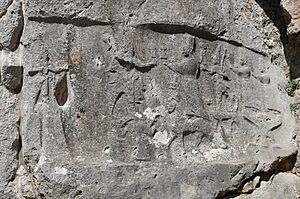
Important Hurrian Gods
Here are some of the main gods in the Hurrian group of gods:
- Teshub: The mighty weather god.
- Hebat: His wife, the mother goddess. She was later seen as the same as the main sun goddess of the Hittites.
- Sarruma: Their son, a mountain god who came from Syria.
- Kumarbi: The grain god and father of Teshub. He was also called a "father of gods," similar to the god Enlil. His home in myths is the city of Urkesh.
- Shaushka: The Hurrian version of Ishtar. She was a goddess of love, war, and healing.
- Shimegi: The sun god.
- Kushuh: The moon god and a protector of promises. Symbols of the sun and crescent moon often appear together in Hurrian art.
- Nergal: A god from Sumer who ruled the underworld. He had an important temple in Urkesh early in Hurrian history. His Hurrian name might be unknown.
- Ea: Also called Hayya, the god of wisdom. He also came from Sumer.
- Allani: Goddess of the underworld.
- Ishara: A goddess who came from Syria.
- Aštabi: A war god.
- Nupatik: An important god whose role isn't fully clear.
- Hutena and Hutellura: Goddesses of fate and birth.
Hurrian cylinder seals often show mythical creatures. These include winged humans or animals, dragons, and other monsters. We're not entirely sure what these pictures of gods and spirits mean. They might have been seen as both protective and sometimes scary spirits. Some are similar to the Assyrian protective spirits called shedu.
The Hurrian gods didn't seem to have special home temples like in Mesopotamian or Ancient Egyptian religion. Some important religious places were Kummanni in Kizzuwatna and Hittite Yazilikaya. Harran later became a religious center for the moon god. Shaushka had an important temple in Nineve when the city was under Hurrian rule. A temple for Nergal was built in Urkesh in the late third millennium BC. The town of Kahat was a religious center in the kingdom of Mitanni.
The Hurrian myth "The Songs of Ullikummi" was kept by the Hittites. It is similar to Hesiod's Theogony from ancient Greece. For example, the story of how one god took power from another in Greek myth is like the Hurrian myth of Teshub and Kumarbi. Some ideas in the worship of Attis might have come from Hurrian stories.
The Hurrian Language
The Hurrian language is related to the Urartian language. Urartian was spoken in the ancient kingdom of Urartu. Together, they form the Hurro-Urartian language family. Experts still debate if Hurro-Urartian languages are related to other language families.
Around 2000 BC, the Hurrians started using the Akkadian language and Cuneiform script for their own writing. Texts in the Hurrian language written in cuneiform have been found at Hattusa and Ugarit (Ras Shamra). One of the longest Amarna letters (EA 27) was also in Hurrian. It was written by King Tushratta of Mitanni to Pharaoh Amenhotep III. This was the only long Hurrian text known until 1983. That year, a large collection of Hurrian literature with Hittite translations was found at Hattusa.
Discovering the Hurrians: Archaeology
Hurrian settlements are found in three modern countries: Iraq, Syria, and Turkey. The main area where Hurrians lived is divided by today's border between Syria and Turkey. Some sites are in this border zone, making digs difficult. New dams being built in the Euphrates, Tigris, and Khabur valleys are a danger to these old sites. Many efforts have been made to save artifacts when dam construction put entire river valleys underwater.
The first major digs at Hurrian sites in Iraq and Syria began in the 1920s and 1930s. American archaeologist Edward Chiera led work at Yorghan Tepe (Nuzi). British archaeologist Max Mallowan worked at Chagar Bazar and Tell Brak. Today, American, Belgian, Danish, Dutch, French, German, and Italian teams of archaeologists are working on new digs and surveys. They work with international partners and the Syrian Department of Antiquities.
The tells, or city mounds, often show a long history of settlement. This can start in the Neolithic period and continue to Roman times or later. The special Hurrian pottery, called Khabur ware, helps archaeologists identify different layers of settlement within the mounds. Hurrian settlements are usually found from the Middle Bronze Age to the end of the Late Bronze Age. Tell Mozan (Urkesh) is the main place where this is different.
Key Archaeological Sites
Here are some important ancient sites from the area where the Hurrians lived:
- Urkesh (Tell Mozan)
- Nuzi (Yorghan Tepe)
- Nagar (Tell Brak)
- Shehna and Shubat-Enlil (Tell Leilan)
- Kahat (Tell Barri)
- Nabada (Tell Beydar)
- Tell Tuneinir
- Umm el-Marra (Tuba?)
- Tell Chuera
- Tell Hammam et-Turkman (Zalpa?)
- Tell Sabi Abyad
- Hamoukar
- Chagar Bazar
- Tell Fekheriye (Sikkan, Washukanni?)
- Tall Al-Hamidiya (Taidu?)
Important discoveries about Hurrian culture and history were also made at Alalakh, Amarna, Hattusa, and Ugarit.
See also
 In Spanish: Hurritas para niños
In Spanish: Hurritas para niños
- Horites
- Nairi
- Hurrian songs


